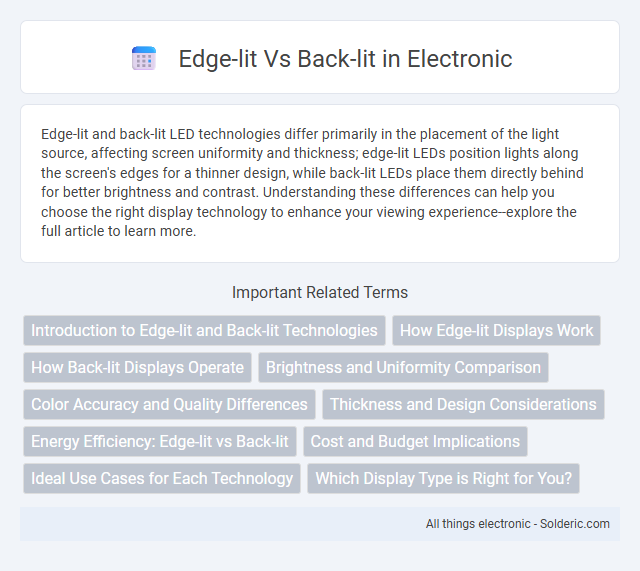Edge-lit and back-lit LED technologies differ primarily in the placement of the light source, affecting screen uniformity and thickness; edge-lit LEDs position lights along the screen's edges for a thinner design, while back-lit LEDs place them directly behind for better brightness and contrast. Understanding these differences can help you choose the right display technology to enhance your viewing experience--explore the full article to learn more.
Comparison Table
| Feature | Edge-lit | Back-lit |
|---|---|---|
| Light Source Position | LEDs placed on screen edges | LEDs placed directly behind the screen |
| Brightness | Moderate brightness | Higher brightness and uniformity |
| Thickness | Thinner design | Thicker display panel |
| Cost | Generally more affordable | More expensive due to better lighting |
| Picture Quality | Good, but less uniform brightness | Superior uniformity and contrast |
| Energy Efficiency | Lower power consumption | Higher power consumption |
| Use Case | Budget TVs, slim monitors | Premium TVs, professional displays |
Introduction to Edge-lit and Back-lit Technologies
Edge-lit and back-lit LED technologies differ primarily in the placement of LEDs within the display panel. Edge-lit LEDs are positioned along the edges of the screen, allowing for thinner designs and energy efficiency, while back-lit LEDs are uniformly distributed behind the screen, offering better brightness and color accuracy. Understanding these distinctions helps you choose the right display technology based on your preferences for design, picture quality, and energy consumption.
How Edge-lit Displays Work
Edge-lit displays use LEDs positioned along the edges of the screen to illuminate the display panel through a light guide plate, delivering thinner and lighter designs. This technology disperses light evenly across the screen, enhancing brightness while maintaining energy efficiency. Your viewing experience benefits from uniform backlighting, though edge-lit TVs may have less consistent brightness compared to back-lit models with direct LED placement.
How Back-lit Displays Operate
Back-lit displays use an array of LEDs positioned behind the entire LCD panel, providing uniform light distribution across the screen. This illumination method enhances brightness and color accuracy by allowing precise control of light intensity through local dimming zones. Such technology improves contrast ratios and reduces light leakage compared to edge-lit displays.
Brightness and Uniformity Comparison
Edge-lit LED displays typically offer slimmer profiles but can suffer from uneven brightness and potential light bleeding along the edges, impacting uniformity. Back-lit LED screens deliver superior brightness levels with consistent light distribution across the entire panel, resulting in better uniformity and enhanced image quality. Understanding these differences helps you choose the right display technology based on your needs for brightness and visual consistency.
Color Accuracy and Quality Differences
Edge-lit displays often struggle with uniform brightness and color consistency due to the positioning of LEDs along the screen's edges, leading to potential color accuracy issues and less vibrant image quality. Back-lit (or direct-lit) displays place LEDs behind the entire screen surface, producing more even illumination, higher contrast ratios, and superior color accuracy ideal for professional or high-quality visual experiences. Enhanced back-lit technology supports richer color gamuts and deeper blacks, making it the preferred choice for applications demanding precise color reproduction.
Thickness and Design Considerations
Edge-lit LED displays are thinner due to LEDs being positioned along the screen edges, enabling sleeker and more lightweight designs ideal for wall mounting and slim profiles. Back-lit LED displays house LEDs directly behind the panel, resulting in greater thickness but offering superior brightness and uniformity, which can influence design choices for environments where display performance outweighs slimness. Choosing between edge-lit and back-lit depends on balancing the desire for minimal thickness and design aesthetics against the need for enhanced brightness and image quality.
Energy Efficiency: Edge-lit vs Back-lit
Edge-lit LED displays consume less power compared to back-lit models due to their use of LEDs positioned along the panel edges, which efficiently distribute light with minimal energy. Back-lit LEDs utilize a full array of LEDs behind the screen, resulting in higher brightness but increased energy consumption. Choosing edge-lit technology can lead to significant energy savings, especially in environments where lower brightness is acceptable.
Cost and Budget Implications
Edge-lit LED TVs typically offer a more budget-friendly option due to their simpler design and lower manufacturing costs, making them ideal for cost-conscious consumers. Back-lit LED TVs, especially those with full-array local dimming, tend to have higher price points attributed to enhanced brightness, contrast, and uniformity, which impacts overall budget considerations. Evaluating the trade-off between initial expenses and desired picture quality is crucial when comparing edge-lit and back-lit display technologies for purchasing decisions.
Ideal Use Cases for Each Technology
Edge-lit displays are ideal for ultra-thin TVs and monitors where sleek design and energy efficiency are priorities, making them suitable for living rooms and office setups with limited space. Back-lit displays provide superior brightness and uniformity, perfect for gaming, professional photo editing, and environments with higher ambient light where color accuracy and vivid visuals matter. Your choice depends on whether you prioritize slim aesthetics and energy savings (edge-lit) or enhanced picture quality and brightness (back-lit).
Which Display Type is Right for You?
Edge-lit displays offer thinner designs and lower power consumption, making them ideal for sleek TVs and monitors in well-lit rooms. Back-lit displays provide superior brightness and more uniform illumination, which enhances contrast and color accuracy, perfect for dark environments and professional use. Choosing the right display depends on your preference for design aesthetics versus image quality requirements.
Edge-lit vs Back-lit Infographic

 solderic.com
solderic.com